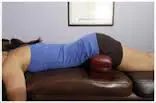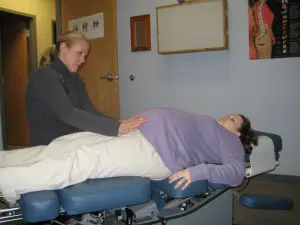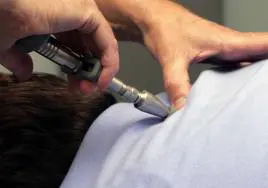Helping Your Body & Brain Communicate Without Interference
Chiropractic care is based on the science and philosophy that the brain and nervous system control all functions of the body, including the immune system, digestive system, reproductive system, musculoskeletal system, and more. In order for the brain to properly communicate with the rest of the body through spinal nerves, the nerve pathways must be free from interference. Misalignments in the vertebrae of the spine, called subluxations, can impede the communication between the brain and the body. Misaligned vertebrae, inflammation, and muscle spasm can slow down or stop communication by “pinching” the pathways that carry the nerve signals from the brain to the body. While pain and decreased range of motion are two conditions that are helped with chiropractic adjustments, there are a number of others that may resolve as well. Many patients have found relief from infertility, digestive issues, fibromyalgia, colic, ear infections, GERD/reflux, menstrual issues, headaches, pregnancy discomforts, and more. Its benefits are truly larger than pain relief.
There are many different chiropractic “techniques”, or methods of adjusting the spine and extremities. At chiropractic college, students learn the basics or the core group of adjusting styles. At Palmer College of Chiropractic, this core group is called the Palmer Package. There are also extra classes that can be taken as electives, and additional post-graduate courses as well. Dr. Trudell has studied a variety of different chiropractic techniques before opening her chiropractic care center and uses a combination to tailor treatment plans specific to the individual. No two patients get the same exact treatment! Below are descriptions of the most common styles of adjustment that Dr. Trudell utilizes.

SOT
SOT stands for Sacro Occipital Technique. “Sacro” means “related to, or associated with,” the sacrum. The sacrum is the foundation for the spine and is often called the tail bone. “Occipital” means “related to or associated with the occiput, which is “the base of the skull”. SOT is a method of normalizing the relationship between the foundation of the spine and the top of the spine. It is the relationship of movement between these two bones that have been proven to be so important in the normal functioning of the brain and spinal cord. SOT was developed by Dr. DeJarnette over 70 years ago. This technique has a very broad scope and includes not just the spine but also cranial bones, visceral organs, extremities, TMJ, and pediatrics. It is very safe and gentle, and you may notice your doctor placing “pelvic blocks” under your hips during an adjustment. These pelvic blocks act as a type of fulcrum and help restore the natural rhythmic motion of cerebrospinal fluid (CSF) throughout the nervous system. Think of CSF as a gentle fluid that bathes the entire brain and spinal cord, just as the oil in your car lubricates your engine. If you don’t change your oil properly, it loses viscosity and gets full of dirt and grime, causing parts in your engine to get hot and wear faster, which causes a lot of damage. If the sacrum and occiput can’t move properly, the CSF can become stagnant, and important nerves (including the brain and spinal cord) can’t get rid of their “dirt” or waste products, which leads to premature wear and tear on different body systems. With SOT, the proper motion is restored and it’s like an oil change each time.
SOT Cranial
“If my skull is fused and solid, how can the cranial bones be adjusted?” Much research has been done to show that even after cranial sutures between the bones of the skull close, there is still a small amount of movement that is detectable. You can’t see this motion, as it is very subtle, but it can be felt as a slight pulsing motion. This motion is absolutely essential for life to exist. If it wasn’t happening, you wouldn’t be reading this right now. The cranial bones, sacrum, and occiput all work together to help move the CSF that was discussed above. Together, they create a “pumping” motion that helps push CSF throughout the nervous system to bathe all the nerves and the brain. There also needs to be a small amount of motion between the cranial bones to help offset pressure changes, or your skull would literally explode. Every time you chew, swallow, sneeze, yawn, cough, or suck, you are changing the pressure dynamics within your skull. If there wasn’t a little wiggle room in there, we would all be in a lot of trouble! And because your very important 12 pairs of cranial nerves exit the brain through tiny holes in these cranial bones, certain problems may be directly related to cranial misalignments. Some of these include migraines or other headaches, trigeminal neuralgia/Tic Douloureux, Bell’s Palsy, ringing in the ears, vertigo, TMJ, and many others. Not all chiropractors work on the cranial bones. Extensive postgraduate education is required to learn these techniques. To learn more about the research on cranial work, visit the SOT websites.

Diversified
Diversified Technique is a classic chiropractic technique, developed by D.D. Palmer, DC, and taught in all chiropractic colleges. The focus is on restoring normal biomechanical function to the spine, and correction of subluxation, or misalignment of the vertebrae. In addition, Diversified methods have been developed to adjust extremity joints, like knees, ankles, and wrists, allowing for beneficial applications in treating sports injuries. Diversified adjusting of the spine uses specific lines of drives for all chiropractic adjustments, allowing for specificity in correcting mechanical distortions of the spine. Neurological and orthopedic exams, patient histories, and review of injury are used in analysis and diagnosis. No instruments are used in the adjusting procedure. Motion palpitation (moving parts of the spine while the doctor feels for “stuck” spots) and hands-on techniques are used to deliver a deeper thrust, which makes an osseous (popping) sound as the adjustment is given. Most patients might recognize this technique from the positions they are in when they get adjusted. Usually, the neck is adjusted while laying on their back on the table, and the low back is adjusted while they are face down on the table. A table with drops may also be used with this technique.
Thompson Drop Table
The main difference between this technique and others is the type of table that is used. This table has different “drop away” sections. There is one for the head/neck area, upper back, mid-back, low back, and pelvis. Each section has tension controls that are adjusted according to the patient’s weight and size. The section is then “cocked” so that when the thrust of the adjustment is delivered, the corresponding section of the table drops along with it. Usually, the patient hears the noise from the table, and may or may not hear a “popping” sound from the adjustment. There are usually 3 quick low force adjustments with the drops. According to Dr. Zemelka, author of the Segmental Drop Adjusting Manual used at Palmer College of Chiropractic, “The reasoning is based on Newton’s Law of Motion, in that when two objects fall through space the energy generated in object number one is transferred to the second object during the drop. Therefore, the force induced by the chiropractor’s thrust into the joint space is enhanced with the drop mechanism.” Patients seem to find this type of adjustment quite comfortable. Extremities like hips and shoulders also adjust well with this method.


Webster Technique
The Webster technique is a specific chiropractic analysis and diversified adjustment. The goal of the adjustment is to reduce the effects of sacral subluxation/ SI joint dysfunction. In so doing neuro-biomechanical function in the pelvis is improved.
Dr. Larry Webster, founder of the International Chiropractic Pediatric Association discovered this adjustment as a safe means to restore proper pelvic balance and function. This specific sacral analysis can be used on all weight-bearing individuals to determine S/I joint dysfunction/ sacral subluxation and is therefore applicable for the entire population. The assessment includes heel flexion to buttocks, with restricted flexion indicating the affected SI joint. Correction is made with a diversified, sacral adjustment. It is used on all weight-bearing individuals presenting with this biomechanical restriction. Common symptoms include (but are not limited to) low back pain, sciatic neuralgia, and symptoms associated with sacral subluxation and/ or S/I joint dysfunction.
The ICPA recognizes that in a theoretical and clinical framework of the Webster Technique in the care of pregnant women, sacral subluxation may contribute to difficult labor for the mother (i.e., dystocia). Dystocia is caused by inadequate uterine function, pelvic contraction, and baby mal-presentation.32 The correction of sacral subluxation may have a positive effect on all of these causes of dystocia.
In this clinical and theoretical framework, it is proposed that sacral misalignment may contribute to these three primary causes of dystocia via uterine nerve interference, pelvic misalignment, and the tightening and torsion of specific pelvic muscles and ligaments. The resulting tense muscles and ligaments and their aberrant effect on the uterus may prevent the baby from comfortably assuming the best possible position for birth.
In regards to pregnant mothers, Dr. Webster reported that when a mother sought care and her baby was in a breech position, the restoration of pelvic neuro-biomechanics with this adjustment also frequently facilitated optimal fetal positioning. There are cases published in the chiropractic literature that support this theory. More research is needed and is currently underway by the ICPA.
The obstetric literature has determined that correct positioning of the baby in-utero affect birth outcome and decrease the potential for undue stress to the baby’s developing spine and nerve system. Obstetric literature has determined the importance of normal pelvic neuro-biomechanics including uterine function and pelvic alignment for the prevention of dystocia (difficult birth). It has also been determined that correct positioning of the baby in-utero affects birth outcomes and decreases the potential for undue stress to the baby’s developing spine and nerve system. Chiropractic literature has determined the significance of sacral adjustments in normalizing pelvic neuro-biomechanics.
It is therefore considered prudent that this specific sacral analysis and adjustment be used throughout pregnancy to detect and alleviate sacral imbalance and optimize pelvic neuro-biomechanics in the mother. Because of the particular female adaptations from the increase of hormones, weight gain, and postural adaptations, pregnant mothers have a greater chance of sacral subluxation and neuro-biomechanical imbalance than the general population. Additionally, because of the effect, the chiropractic adjustment has on all body functions by reducing nerve system stress, pregnant mothers may have significant benefits by having their spines checked regularly throughout pregnancy, optimizing health benefits for both the mother and baby.
Basically, think of your uterus as a huge balloon in the Macy’s Parade. Each balloon is tethered with 6-10 ropes that people on the ground hold onto, just as the uterus is attached to the sacrum, pelvic bones, and other organs with 9 ligaments. If the anchors on the ground start walking in different directions and don’t pull the balloon in a balanced fashion, the balloon may start to twist and lean off to one side. The same thing happens in the pelvis. When the bones are out of alignment, it directly leads to the uterus being twisted or off-center. Since space is already limited in the uterus for a growing baby, when you make one side tight and restricted, there is even less room. Imagine how much more comfortable your baby would be if he or she had the most room possible to turn and stretch. If sacral or pelvis misalignments are causing your baby to be in anything but the most optimal position for birth, your chiropractor will find them. It is important to realize that this is not a breach turning technique, and not to confuse this with the medical procedure called External Cephalic Version.
Activator
The Activator is a small handheld adjusting instrument that was designed to deliver a fast and more specific dynamic thrust. It uses a gun-type mechanism that delivers an accurate percussive thrust upon triggering. The activator instrument controls the force and speed of the adjustment exceptionally well and with the activator, the line of drive can be more specific. There are different tension settings for adjusting various areas of the body, from very soft for adjusting the neck, to a bit more powerful for the strong bones in the low back and hips. The instrument can be used on patients of all ages, but it works especially well with the elderly, pregnant patients, and infants and children. It also works well for adjusting small bones in the extremities, like wrists and feet. Besides being a method of adjusting, it also has its own subluxation diagnosis protocol by using a series of leg checks.

